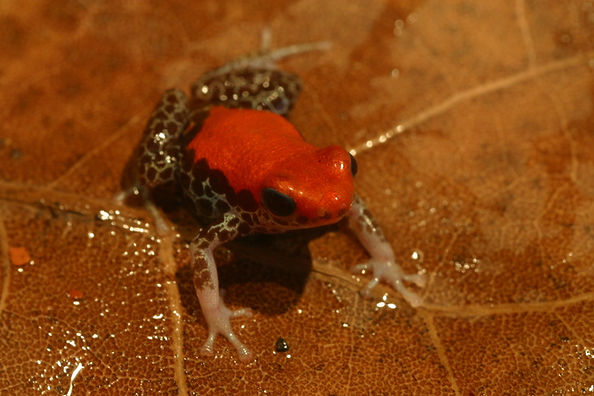2- Ranitomeya reticulatus (Boulenger 1884)
courtesy to : frogsandmore.nl/nl/product/ranitomeya-reticulata/
13-17mm large with mostly fully colored red back. The underside of the back, flanks, buzz and legs are covered with a network of blue to gray-white drawing on a black background. A small red spot is present on the throat against the lower jaw.
Geographical variation:
The typical completely red-colored spine occurs in Rio Nanay-Drainage, Iquitos, Loreto Peru. Striped varieties occur in the Rio Itaya Drainage Peru, Hameau Kuiru Brazil and Rio Caqueta-Drainage Colombia.
Call: A quick repetition of buzz calls with lower pitch than R. ventrimaculata
Distribution:
Peru Iquitos, Rio Nany Drainage, Rio Itaya Drainage to the Hameau Kuiru, Brazil and the Rio Caqueta Drainage in Colombia.
Ecology:
The frogs are found on the forest floor of lowland rainforest. They are strict ground dwellers and eggs (2-3, dark gray) are often placed between fallen leaves, but are also found in bromeliads.
The terrarium:
A terrarium of 70 × 50 × 50 may be too small for two males and two females. The oppressed male can quickly pay for it with death. For others who for example hold three couples in a bin of 60 × 60 × 40 cm or even much smaller containers of 30 × 40 × 40 cm, well-breeding animals are the result. It therefore seems that territory formation is possible with a large container and with that also the oppression of other males. With smaller containers, this territory formation may not be possible, which means that problems do not occur. Whether this really is the case should be better examined.
The bin can be set up as a standard poison dipper bin with some wood, bromeliads and some climbing plants. Some leaf waste on the bottom makes a nice whole.
Temperature:
The temperature during the day will be around 24 - 25 ° C and may drop to 22 ° C during the night.
Groupwise / pairwise:
Pairwise is recommended because of the aggressive nature of the males. However, groups want to succeed with some luck. Also the breeding is sometimes possible in groups.
Eggs:
The eggs, 2-3 mm in number, are usually deposited on horizontal smooth surfaces, but Harald Garretsen (1995: 36) reports the deposition on a side window. Black tubes of slide films are, according to many, a popular outlet. The eggs come out after 8-11 days.
Other growing information:
The experiences with keeping this species are quite different, it is not easy to keep and breed. With some experience and good conditions, however, it is quite possible.
Both male and female bring the larvae one by one to a pond like a film cooker or the armpit of a bromeliad leaf. Helmut and Elke Zimmermann observed the deposition of food eggs by the female with the larvae, but artificial breeding also succeeds. After about 2 months, the larvae metamorphose into frogs of about 1 cm in size. Springtails are indispensable for rearing, also the parent animals like to enjoy them, besides small fruit flies and all kinds of other small insects. After eight months the animals are again mature.
Morphs :
courtesy to :
- www.ranitomeya.com/reticulata/
1- Iquitos - Understory :
This line of reticulata comes from Iquitos, Peru by way of Understory Enterprises. My adults are a mixture of solid and spotted frogs. These frogs have proven much easier to breed and the young easier to raise than the old line frogs.




2- Striped :
A line of frogs from Understory Enterprises that produces frogs that keep their juvenile striped pattern into adulthood.




3-Solid - Old Lines :
My R. reticulata 'Solid' are from multiple older lines that produced froglets with white feet from time to time. Unfortunately, the whitefooted froglets were not as sturdy as the typical ones and the heterozygous offspring didn't produce many whitefooted froglets. While I still have frogs from the line, I don't think the whitefoot gene is present anymore.




4- Whitefoot - Old Lines :




Madagascar Dart frogs
Aromobatidae :
-
Allobatinae
-
Anomaloglossinae
-
Aromobatinae
South America Dart Frogs - Species
Dendrobatidae :
-
Colostethinae
-
Dendrobatinae
-
Hyloxalinae
Ranitomeya genus :
Ranitomeya Species :
1- Ranitomeya imitator ( Mimic poison frog ) , SCHULTE, 1986 :
Part 1 .. Part 2 .. Part 3 .. .. Part 4
2- Ranitomeya amazonica , Schulte, 1999 :
3- Ranitomeya fantastica - The red-headed poison frog - Boulenger, 1884
4- Ranitomeya vanzolinii - the Brazilian poison frog or spotted poison frog- Myers, 1982 :
5- Ranitomeya variabilis - The splash-back poison frog - Zimmermann and Zimmermann, 1988
5- Ranitomeya reticulata - Red-backed poison frog - Boulenger 1884 :
6- Ranitomeya benedicta - blessed poison frog - Brown, Twomey, Pepper,
7-Ranitomeya lamasi - Morales, 1992
Part 1 .. Part 2 .. Part 3 .. .. Part 4
8- Ranitomeya summersi - Summers' poison frog - Brown, Twomey, Pepper, and Sanchez-Rodriguez, 2008
Ranitomeya genus :
Ranitomeya Species :
1- Ranitomeya imitator ( Mimic poison frog ) , SCHULTE, 1986 :
Part 1 .. Part 2 .. Part 3 .. .. Part 4
2- Ranitomeya amazonica , Schulte, 1999 :
3- Ranitomeya fantastica - The red-headed poison frog - Boulenger, 1884
4- Ranitomeya vanzolinii - the Brazilian poison frog or spotted poison frog- Myers, 1982 :
5- Ranitomeya variabilis - The splash-back poison frog - Zimmermann and Zimmermann, 1988
5- Ranitomeya reticulata - Red-backed poison frog - Boulenger 1884 :
6- Ranitomeya benedicta - blessed poison frog - Brown, Twomey, Pepper,
7-Ranitomeya lamasi - Morales, 1992
Part 1 .. Part 2 .. Part 3 .. .. Part 4
8- Ranitomeya summersi - Summers' poison frog - Brown, Twomey, Pepper, and Sanchez-Rodriguez, 2008